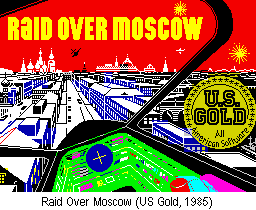|

By Lloyd Mangram
April
1985
Issue 15
|
|
After
the Christmas cover and those of the two previous issues,
Oliver wanted to get back to the feeling generated by
Issue One's picture, a strong, grotesque, large-face
image. The impact of this technohorror is undeniable,
working even more effectively when you compare its organic,
slavering toothiness and the multifaceted, fly-like
eyes. But a closer examination of the brilliant eyes
reveals them to be illuminated Spectrum keyboards, the
famous colours just picked out in a refracted flare
at the bottom left. This painting was not related to
any known game.
|
In March we had reviewed Richard Shepherd's Ski Star 2000,
a sports simulation by Pete Cooke, remarkable for having a
downhill-course construction kit and its use of icons - it
was the first game to really implement this new 'user-friendly'
technique. Sadly, it was to be Shepherd's last release. The
text-adventure market had shrunk financially and Shepherd's
almost total dependence on the genre left the business vulnerable.
Only those with powerful adventure product could hope to succeed:
houses like Level 9, for instance.
In April stalwart Micromega came up with the disappointing
Day In The Life, a spoof on Sir Clive Sinclair. It
proved to be Micromega's last game, and the label was absorbed
into its commercial-programming parent company as quietly
as a ship sliding under the waves.
April's issue presented more features than had been possible
before. Articles on Mizar, Scott Adams, pop/computer star
Chris Sievey and the regular cover-artist slot showed clearly
the effect of having more writers on the staff. Two new regular
sections appeared: Tech Niche, soon to attract the talents
of Simon N Goodwin, and my Merely Mangram preview column -
recognition of the increasing importance to readers of early
games news, and made possible by Robin taking over the Playing
Tips.
But we effectively lost a reviewer at this point; after 15
months of unremitting critical game-playing, Matthew Uffindell
felt he had burned out. He had borne the brunt, writing a
comment on every game ever reviewed, and now he felt it was
time to concentrate on his other CRASH job up in the art department,
the technical side of making printers' halftone pictures and
the rudimentary film-planning techniques which he and Roger
Kean were developing. Though Matthew remained on the masthead
as a contributing writer for several more months, he handed
over his function to the very capable Jeremy Spencer, coming
down to editorial thereafter only on rare occasions.
For three years the magazine Leisure Electronics Trade had
organised a computer-entertainment trade show, and at the
start of this issue their biggest show yet was held at London's
Olympia. It was a huge success, though at the time no-one
knew it would be the last and that before the year was out
LET would cease publication. At the show a tall, bespectacled
young man wearing an atrociously-coloured Hawaiian shirt under
a dark jacket approached Roger Kean and announced himself
to be a runner-up in the CRASH Reviewers' Competition. It
was John Minson, then setting out to break into journalism.
What he wanted was an opportunity to write for CRASH, and
soon enough he would do so.
 Also
at the LET Show, exhibiting for the first time, was System
3. Its cheerfully aggressive proprietor Mark Cale had his
first Spectrum product almost ready and wanted a Smash for
it. He got the game in just before the issue closed for press,
and Death Star Interceptor was a Smash. So was US Gold's
Raid Over Moscow, the CRASH team happily oblivious
to the controversy raging in both trade and consumer press
about the game's dubious political xenophobia. Also
at the LET Show, exhibiting for the first time, was System
3. Its cheerfully aggressive proprietor Mark Cale had his
first Spectrum product almost ready and wanted a Smash for
it. He got the game in just before the issue closed for press,
and Death Star Interceptor was a Smash. So was US Gold's
Raid Over Moscow, the CRASH team happily oblivious
to the controversy raging in both trade and consumer press
about the game's dubious political xenophobia.
An unusual hit came from a company better known for utilities
than games: Romantic Robot, which produced Wriggler.
Jeremy fell in love with the cute graphics, but it was Robin
Candy's favourable decision on playability that made it a
Smash. Everyone, however, considered Alien 8 to be
marvellous despite the climate of opinion on Ultimate's releases
and their continuing similarities. The Ultimate debate would
dominate my letters pages for ages, but I still think Alien
8 deserved its accolade.
|